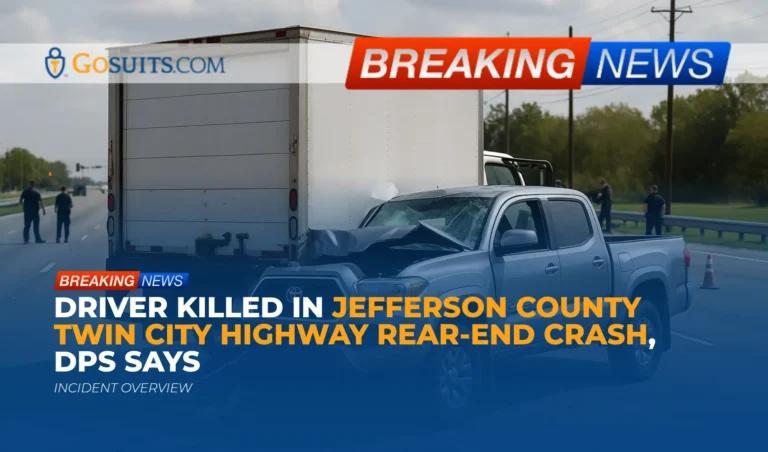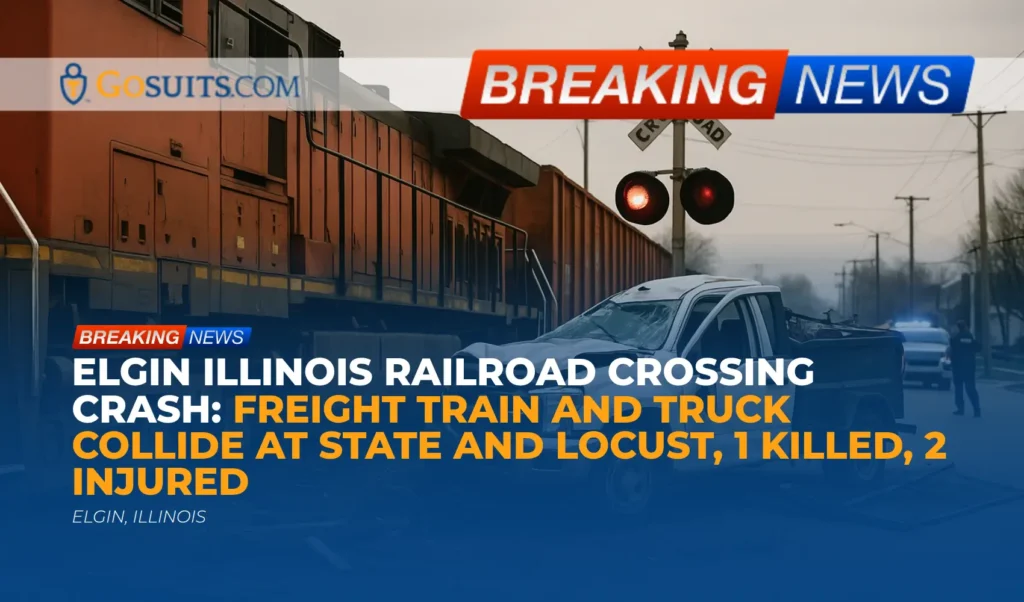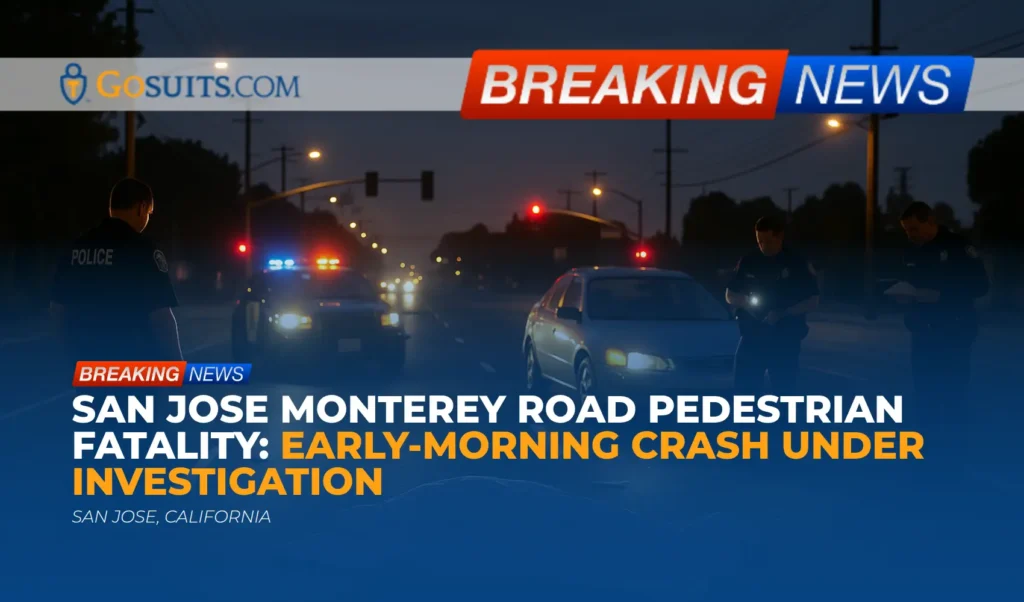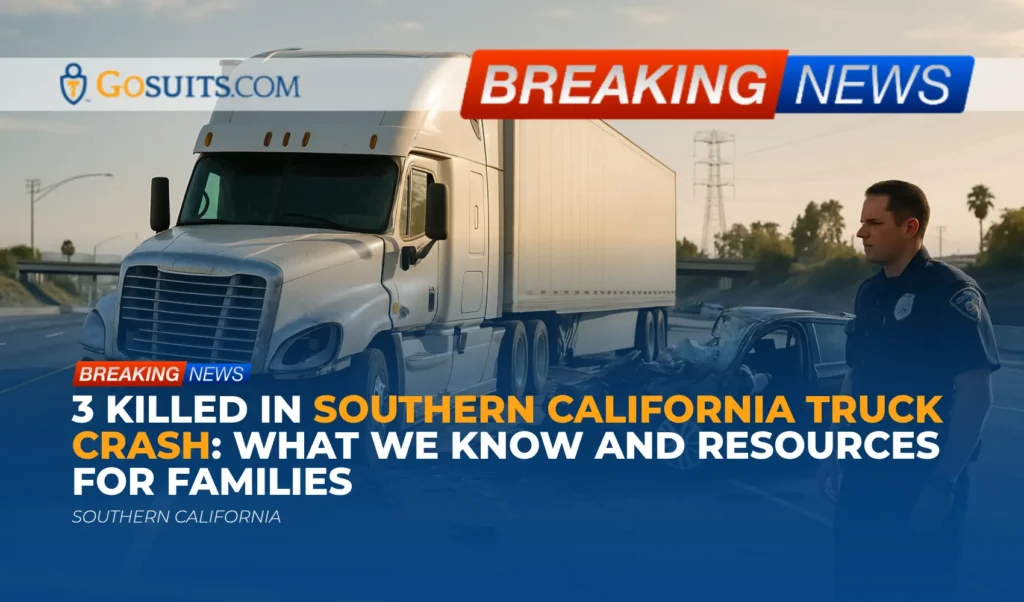- Incident overview
- What we know so far from DPS
- Roadway context: Twin City Highway and turning movements
- Investigation and evidence likely to matter
- Potential civil liability considerations
- Rights of surviving family members under Texas law
- How to obtain official records and practical help
- Insurance and commercial vehicle issues
- Safety takeaways for the community
- Commentary from Gosuits Jefferson County, Texas Personal Injury Attorney
- Time-sensitive actions that matter after a fatal crash
- Sources and public data cited
Incident overview
Authorities in Jefferson County report a fatal crash late Thursday morning on Twin City Highway near Lone Star Drive, close to the OCI plant. According to early information from the Texas Department of Public Safety (DPS), a northbound box truck slowed to make a left turn. A Toyota Tacoma pickup traveling behind the box truck struck it from the rear. The driver of the Toyota died at the scene. The driver of the box truck and an adult passenger were not injured. DPS is working to notify next of kin, and formal identification has not been publicly released at the time of reporting.
Crashes at or near left-turn locations along high-speed corridors can unfold quickly, and even momentary inattention or misjudgment of stopping distance can have severe consequences. DPS troopers remained on scene to examine the vehicles, document roadway markings, and gather witness statements as part of the ongoing investigation.
What we know so far from DPS
Key facts reported
- Time and date: Approximately 11:45 a.m., Thursday
- Location: Twin City Highway near Lone Star Drive, close to the OCI plant, Jefferson County
- Vehicles: Northbound box truck ahead; Toyota Tacoma following behind
- Sequence: Box truck slowed to turn left; Toyota struck the rear of the box truck
- Outcomes: Toyota driver deceased at scene; box truck driver and one passenger uninjured
- Status: DPS investigating; next-of-kin notification in progress
This description is preliminary and may be refined as investigators review physical evidence, vehicle data, and any available video or witness accounts.
Roadway context: Twin City Highway and turning movements
Twin City Highway is a key corridor in Jefferson County connecting neighboring communities and industrial facilities. Left turns on multi-lane or higher-speed highways introduce conflict points where vehicles must decelerate and cross or enter opposing lanes. Safe navigation depends on adequate signal use, functioning brake and tail lamps, appropriate following distance, and situational awareness by all drivers.
Rear-end collisions constitute a large share of traffic crashes nationally, and they often occur when a leading vehicle slows or stops to turn, or in response to traffic conditions ahead. Federal safety research notes that forward collision warnings and attentive following distances can reduce rear-end crash risk. While technology is helpful, the fundamentals of safe driving—keeping sufficient space, scanning ahead, and anticipating turns—remain critical.
Investigation and evidence likely to matter
What investigators commonly review
- Scene documentation: Measurements and photographs of skid marks, yaw marks, debris fields, fluid trails, and final rest positions help reconstruct speeds, braking, and impact angles.
- Vehicle inspections: Condition of brake lamps and turn signals, tire condition, and post-impact functionality can be important. In Texas, stop lamp and turn signal requirements are set in statute, and investigators often verify whether lamps were present and operational before impact based on filament analysis and other clues.
- ECM and telematics: Many trucks and newer vehicles contain electronic control modules and telematics systems that record speed, throttle, and braking inputs seconds before a crash. Commercial box trucks may also have fleet telematics or dash cameras.
- Witness statements and video: Eyewitnesses, nearby business cameras, or in-cab dash cams can clarify whether the box truck signaled and slowed gradually, and what actions the following driver took.
- Lighting and sight lines: Sun angle, weather, and roadside features can affect visibility. Investigators consider these factors when assessing reaction time and stopping distance.
Why timing and distance matter
Stopping distance increases with speed and vehicle weight. Even if a following driver reacts, they need ample space to avoid a collision when a lead vehicle slows to turn left. Conversely, leading vehicles should signal their intent and decelerate in a predictable manner so following traffic can respond. The balance of these responsibilities is often central in civil liability analyses after rear-end crashes.
Potential civil liability considerations
While many rear-end collisions result in fault being assigned to the following driver for not maintaining an assured clear distance, liability is not automatic. Investigators and insurers may examine multiple avenues of potential fault and contributing factors. From a personal-injury perspective, these considerations often arise:
- Following distance and speed: Texas law requires drivers to maintain an assured clear distance so they can stop safely without colliding with the vehicle ahead. Whether the following distance was reasonable given speed, traffic, and conditions is a common issue.
- Turn signaling and brake lamps: A leading vehicle turning left should give appropriate signal continuously for at least 100 feet before turning when practical, and brake lights must be functional. If lamps were inoperative or the turn was abrupt without signaling, questions can arise about the lead vehicle’s share of responsibility.
- Commercial vehicle duties: If the box truck is operated by a commercial carrier, the company has duties related to driver qualification, hours-of-service compliance, inspection and maintenance, and safe operation. Company policies, training, and vehicle condition may be scrutinized.
- Comparative responsibility: Texas follows proportionate responsibility rules. If multiple parties share fault, damages can be reduced according to each party’s percentage of responsibility, and recovery is barred if a claimant’s responsibility exceeds a statutory threshold.
It is important to avoid assumptions about fault until the full facts are known. Physical evidence, electronic data, and witness accounts typically drive these determinations.
Rights of surviving family members under Texas law
When a crash results in a fatality, Texas law provides pathways for certain relatives to pursue civil claims associated with the loss. Without predicting outcomes, these are general frameworks that may apply in fatal crash cases:
- Wrongful death claims: In Texas, the spouse, children, and parents of the deceased may bring a wrongful death action. This type of claim focuses on harms suffered by the surviving family members due to the loss.
- Survival claims: Through a survival action, the decedent’s estate may pursue claims the person could have brought had they survived, such as pain experienced before passing and certain economic losses.
- Time limits: Texas sets deadlines for filing personal injury and wrongful death actions. These timeframes are strict, and waiting too long can affect the ability to bring claims.
Discussing these options in a confidential consultation can help families understand timelines, evidence preservation, and how insurance coverage may apply, all without making any commitments or decisions on the spot.
How to obtain official records and practical help
Police crash report
In Texas, crash reports completed by DPS troopers are filed in the state’s system. Eligible requestors can obtain the official CR-3 crash report through the Texas Department of Transportation’s Crash Records Information System. Reports are typically available within days to weeks, depending on processing. The purchase portal and instructions are available at TxDOT CRIS Crash Reports.

Autopsy and death investigation records
Texas handles death investigations either through a county medical examiner’s office where one exists, or through a Justice of the Peace acting as coroner. The governing statutes outline when an inquest is required and how examinations are conducted. Families can ask the local medical examiner or Justice of the Peace about the status of an autopsy report and the procedure for obtaining copies once available. General statutory guidance is at Texas Code of Criminal Procedure, Chapter 49.
Please note that autopsy report release timelines vary. Portions of files may be withheld until investigations conclude, and some content may be subject to privacy protections. If in doubt, politely request written instructions from the office handling the inquest.
Death certificates
Certified death certificates in Texas are issued through the Texas Department of State Health Services Vital Statistics Unit or through local registrars. These documents are often needed for insurance claims and estate matters. Information on eligibility, fees, and how to order is available at the Texas DSHS Vital Statistics portal: Texas DSHS Death Records.
Vehicle location and towing
After serious crashes, vehicles are commonly removed to a licensed vehicle storage facility. If the location of a vehicle is unknown, the investigating agency or dispatch non-emergency line can often provide the tow company name. In Texas, vehicle storage facilities are regulated at the state level; guidance for consumers, including retrieval requirements, is provided by the Texas Department of Licensing and Regulation at TDLR Towing and Vehicle Storage.
Traffic engineering or roadway information
Families sometimes seek to understand whether roadway design, signage, or signal timing could have contributed to a crash. The Texas Department of Transportation manages many highways and can provide public information on traffic volumes, speed limits, and project plans. For general safety information and programs, visit TxDOT Safety.
Insurance and commercial vehicle issues
Commercial box trucks and carrier obligations
If the box truck is operated in commerce and meets federal thresholds, the company and driver may be subject to Federal Motor Carrier Safety Regulations covering driver qualification, hours of service, vehicle inspection and maintenance, and recordkeeping. Relevant rules are administered by the Federal Motor Carrier Safety Administration (FMCSA). An overview of applicability and core safety regulations appears at FMCSA Regulations.
In serious crashes, attorneys often send preservation notices to commercial carriers to safeguard potentially critical evidence, such as:
- Electronic logging device (ELD) data, GPS and telematics
- Driver qualification and training records
- Pre- and post-trip inspection reports and maintenance files
- Company policies on turning, signaling, and hazard procedures
- Dash camera footage from forward and cab-facing cameras
Insurance contact and recorded statements
Insurance carriers often reach out quickly after serious collisions. Before speaking with any insurance representative or providing a recorded statement, it is prudent to consult with a qualified attorney in a free consultation. What is said early can shape liability assessments and may be used later in ways that are not obvious at the time. A brief legal consultation can clarify rights, coverage layers, and evidence needed, and can provide guidance on whether, when, and how to communicate with insurers.
Safety takeaways for the community
- Leave more room than you think: At highway speeds, a safe following distance is essential. Increase space when approaching intersections, driveways, or known turn locations.
- Read the road ahead: Watch for brake lights, turn signals, and cues that a vehicle may turn left, such as a vehicle drifting toward the centerline or slowing near a median opening.
- Signal early and predictably: If you plan to turn left on a high-speed roadway, signal well in advance and brake gradually to give following drivers time to react.
- Avoid distractions: Even a brief glance away can erase critical reaction time. Put phones on Do Not Disturb and keep eyes up.
- Check lights often: Ensure brake lights and turn signals are working. A quick check before driving can prevent misunderstandings on the road.
These reminders do not speak to fault in this specific crash, which remains under investigation, but they align with long-standing safety research and Texas roadway rules.

Commentary from Gosuits Jefferson County, Texas Personal Injury Attorney
Our hearts go out to the family and friends grieving after this tragic loss. This summary is provided for educational purposes and general information to help the community understand what investigators look for and the options Texas law makes available to surviving families.
In a crash like the one reported on Twin City Highway, the civil analysis often turns on details about signaling, braking, and the time and distance available to the following driver. When a commercial vehicle is involved, there are additional layers to evaluate, including whether company policies and maintenance practices were followed and whether the turn and deceleration were executed in a way that reasonably alerted traffic behind.
In our experience, insurance companies and corporate carriers move quickly to shape the narrative. Adjusters may seek recorded statements, ask broad questions, or request documents before families have a chance to gather the facts. That early activity can put those who are grieving at a disadvantage. Without guidance, it is easy to overlook key evidence like dash camera footage, electronic control module data, or nearby surveillance video that can clarify what really happened.
A timely, free consultation can level the playing field. It can help clarify what to preserve, how to obtain the official crash report, and whether additional investigations—such as a private scene inspection—might be worthwhile. There is no obligation to proceed beyond a consultation, and taking the time to understand rights and timelines can prevent unintended waivers or missed deadlines later.
Time-sensitive actions that matter after a fatal crash
The period immediately following a serious collision is stressful, and key evidence can disappear quickly. The following steps describe what can be done, why it matters, and when timing is most critical.
- Request the official crash report: Obtain the CR-3 crash report through the state system once available. The report identifies involved parties, basic diagrams, and insurance information. Acting within the first few weeks helps align next steps with verified facts.
- Preserve electronic evidence: Ask that any dash cam footage, vehicle event data, and telematics from all involved vehicles be preserved. Many systems overwrite within days. Acting within 7 to 14 days can be decisive.
- Secure nearby camera footage: Businesses or industrial facilities near the scene may have video with short retention cycles. A courteous, prompt request improves the chances of saving relevant clips. This is most urgent in the first 3 to 10 days.
- Obtain autopsy and death certificate when available: These records can be needed for benefits and insurance claims. Understanding the process early avoids delays when claims are filed.
- Document the scene and vehicle: If possible, photograph the vehicle at the storage lot and the area of the roadway (from a safe location). Early documentation can capture details before repairs, repaving, or removal of markings.
- Consult an attorney before speaking with insurers: A brief, no-cost consultation can help decide if and when to communicate with insurance carriers. Statements made early can be used later, so being prepared is important.
- Track deadlines: Texas imposes strict filing deadlines for civil claims. Getting oriented within the first few weeks helps ensure that no time limits are missed.
Taking these steps promptly preserves options, even if no immediate decisions are made about claims or litigation.
Sources and public data cited
- Texas Department of Transportation: CRIS Crash Reports (official crash report portal)
- Texas Code of Criminal Procedure, Chapter 49 (Inquests; Medical Examiners)
- Texas Department of State Health Services: Death Records
- Texas Department of Licensing and Regulation: Towing and Vehicle Storage
- Texas Transportation Code § 545.062 (Following Distance—Assured Clear Distance)
- Texas Transportation Code § 545.104 (Turn Signal Requirements)
- Texas Transportation Code § 547.322 (Stop Lamps Required)
- Texas Civil Practice and Remedies Code Chapter 33 (Proportionate Responsibility)
- Texas Civil Practice and Remedies Code § 71.004 (Wrongful Death Beneficiaries)
- Texas Civil Practice and Remedies Code § 71.021 (Survival Actions)
- Texas Civil Practice and Remedies Code § 16.003 (Limitations Period—Injury and Wrongful Death)
- Federal Motor Carrier Safety Administration: Core Safety Regulations
- National Highway Traffic Safety Administration: Crash Stats (rear-end crash data and safety research)






